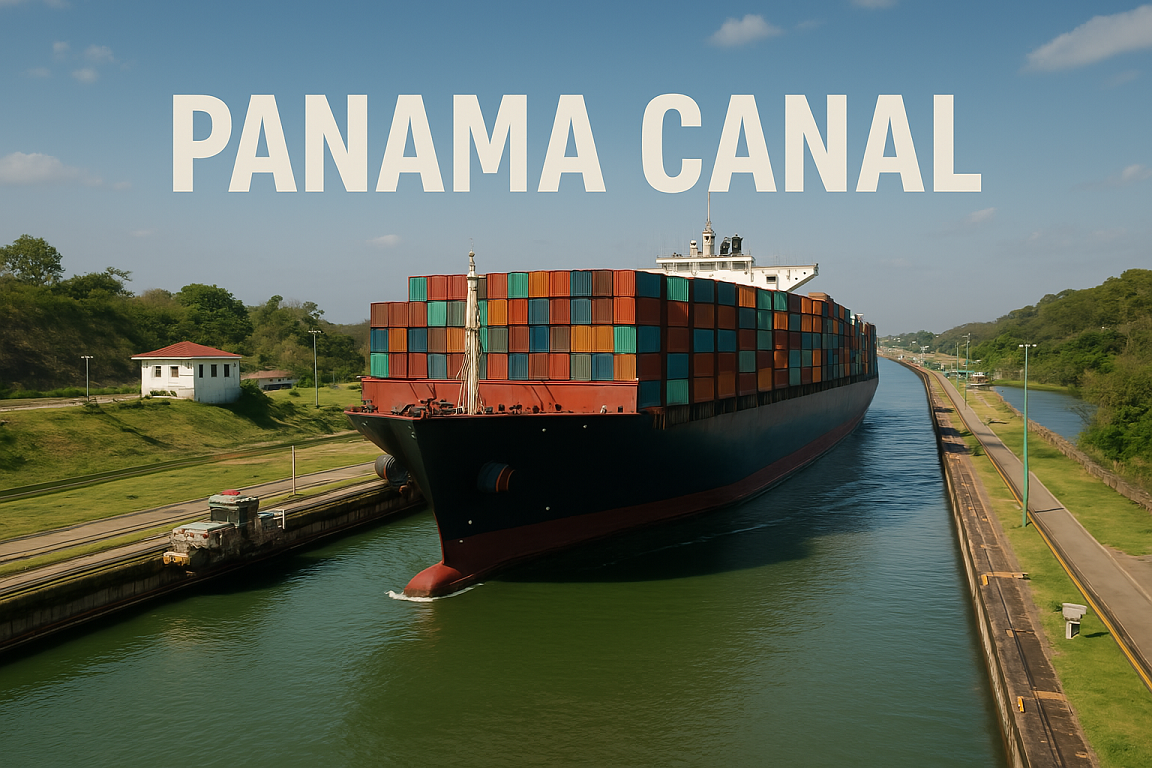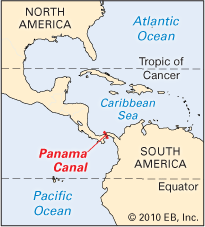04/13/2025
Explore the top Panama Canal trends in 2024, from reduced ship transits and drought-related water issues to Trump’s geopolitical claims. Learn about cruise ship recovery, infrastructure improvements, and global trade implications.
Panama Canal
The Panama Canal: History, Importance, and Geopolitics
The Panama Canal is one of the world’s most critical maritime shortcuts, connecting the Atlantic and Pacific Oceans through a 50-mile artificial waterway in Central America. Since its opening in 1914, it has revolutionized global trade by eliminating the need for ships to navigate the treacherous Cape Horn route around South America. The canal handles 6% of global maritime trade, with over 14,000 transits annually, making it indispensable for container ships, LNG carriers, and bulk commodity transporters.
History and Construction
The canal’s origins trace back to French efforts in the 1880s, which failed due to disease and financial problems. The U.S. later took over the project, completing it in 1914 after overcoming engineering challenges like the Culebra Cut and implementing lock systems to manage elevation changes. The Panama Canal Treaty of 1977 eventually transferred control from the U.S. to Panama, with full ownership handed over in 1999.
Geography and Engineering
The canal consists of a series of locks (Gatun, Miraflores, and Pedro Miguel) that lift ships 85 feet above sea level, crossing the Isthmus of Panama via Gatun Lake. A major expansion in 2016 introduced Neopanamax locks, allowing larger vessels (up to 14,000 TEU containers) to transit, boosting capacity and economic value.
Governance and Ownership
The canal is managed by the Panama Canal Authority (ACP), a Panamanian government agency. Revenue from tolls—which can exceed $3 billion annually—funds national infrastructure and maintenance. The ACP ensures operational efficiency while balancing geopolitical pressures, as the canal remains a strategic asset for global trade.
Why the Panama Canal Still Matters in 2024
Geopolitical and Economic Importance
The canal is a chokepoint for U.S.-Asia trade, particularly for LNG exports and Chinese imports. Droughts and climate change have recently caused water shortages, forcing transit restrictions and raising concerns about long-term reliability. Geopolitical tensions, such as U.S.-China competition, also influence canal operations, as alternative routes (like Nicaragua’s proposed canal or Arctic passages) remain uncertain.
The Panama Canal remains one of the world’s most strategic maritime corridors, linking the Atlantic and Pacific Oceans and handling around 5% of global maritime trade. But in 2024, this historic waterway has found itself at the crossroads of climate disruption, political controversy, and innovation.
⛴️ Traffic Reductions: The Drought That Slowed the Canal
In 2024, the Panama Canal faced one of its worst droughts in decades, severely affecting water levels needed to operate its lock systems.
📉 Key Statistics:
- 21% drop in transits during FY2024 compared to FY2023
- Daily slots were limited to preserve water
- Total transits fell by 29%, especially for bulk carriers and container ships
Despite these constraints, the Panama Canal Authority (ACP) managed to:
- Increase revenues by 1%
- Reduce operating costs by 5%
💡 Top Search in 2024: “Panama Canal drought impact on global shipping”
🛳️ Cruise Ship Transits: A Bright Spot in Troubled Waters
While cargo traffic dipped, the cruise sector showed resilience.
Highlights:
- Over 225 cruise ships expected for the 2024–2025 season
- Cruise giants like Carnival, Norwegian, and Royal Caribbean retained their Panama itineraries
- Tourism demand surged as travelers sought unique experiences passing through the famous locks
This sector helped maintain regional economic activity and Panama’s tourism image during otherwise challenging times.
💧 Water Management and Infrastructure Projects
With climate change altering rainfall patterns, the ACP initiated several key projects:
🌊 Key Developments:
- A proposed Indio River Reservoir to secure long-term water availability
- The Neopanamax Locks’ draft was increased to 49 feet, enabling larger ships despite water limitations
These efforts reflect a long-term shift toward climate-adaptive canal operations.
💼 Economic Impact and User Statistics
Despite fewer transits, the Panama Canal remained a vital artery in global trade.
Top Canal Users in 2024:
-
🇺🇸 United States – 74.7% of total cargo
-
🇨🇳 China – Key exporter/importer for containerized goods
-
🇯🇵 Japan – Particularly in vehicle and tech equipment shipping
The canal exceeded financial forecasts, thanks to:
- Higher tolls per transit
- Increased efficiency through digital management
- Prioritization of long-term slot allocations for Neopanamax vessels
⚙️ Technological and Operational Improvements
Innovation was essential to cope with 2024’s challenges.
Notable Improvements:
-
Long-Term Slot Allocation Method: Improved predictability for larger vessels
-
18% increase in container handling at key terminals compared to 2023
-
Implementation of digital queueing and forecasting tools
These tools allowed better resource use and traffic management under constrained conditions.
🌐 Trump and the Panama Canal: The Geopolitical Controversy
🗣️ Trump’s Claims:
Former U.S. President Donald Trump made repeated statements suggesting that China “controls” the Panama Canal, reigniting debates over sovereignty and influence.
- Trump called for the U.S. to “take back” the canal
- He expressed national security concerns over “high transit fees” and China’s trade routes
- Inflammatory suggestions included the use of military force—a proposal widely criticized as impractical and provocative
🇵🇦 Panama’s Response:
Panama strongly rejected these claims, emphasizing:
- Full sovereignty since the U.S. handover in 1999
- Transparency and neutrality in canal operations
- A commitment to international law and trade freedom
🎙️ Quote: “The Panama Canal is and remains Panamanian,” – Panamanian Foreign Ministry, 2024
🧭 U.S. Diplomatic Position:
While Senator Marco Rubio voiced concerns about Chinese investments in Latin America, the U.S. State Department reaffirmed a desire to strengthen U.S.–Panama ties rather than provoke conflict.

📈 Future Outlook: Toward Stability and Resilience
Despite short-term setbacks, the Panama Canal is positioning itself for a sustainable future.
Forecasts:
-
Rainy seasons in late 2024 may normalize water availability
-
Cruise and tourism growth expected to continue
-
Modernization projects could boost capacity by 2026
-
Diplomacy is likely to prevent escalation of geopolitical tensions
📊 “Panama Canal recovery timeline 2025” is among the top search queries as stakeholders look to long-term solutions.
📌 Top Trending Searches on the Panama Canal in 2024
-
“Panama Canal traffic reduction due to drought”
-
“Cruise ship transits through the Panama Canal 2024”
-
“New water reservoir Panama Canal project”
-
“Trump comments on Panama Canal control”
-
“Panama Canal draft limits 2024”
-
“Panama vs. China shipping influence”
-
“Slot allocation method for Neopanamax ships”
-
“Panama Canal expansion and modernization plan”
❓ FAQs – People Also Ask
❓Why did traffic through the Panama Canal decline in 2024?
Due to severe drought conditions, water availability was limited, reducing the number of daily ship transits.
❓Does China control the Panama Canal?
No. The Panama Canal is under Panamanian sovereignty and is managed by the Panama Canal Authority, an autonomous government agency.
❓How is Panama addressing water shortages?
By exploring new reservoir projects like the Indio River proposal and optimizing water-saving lock operations.
❓Can cruise ships still transit the canal?
Yes. Cruise activity remained strong in 2024, with 225+ ships expected during the tourist season.
❓Is military action by the U.S. on the table?
While Donald Trump made strong remarks, current U.S. officials have not endorsed military involvement. Diplomatic channels remain active.
🧭 Conclusion: A Year of Challenge, Change, and Charting a New Course
In 2024, the Panama Canal faced the dual pressures of climate and controversy. From severe droughts and reduced traffic to controversial political claims, the canal remained a symbol of how global trade, climate resilience, and geopolitics are deeply intertwined.
Yet through strategic planning, innovation, and diplomacy, the canal stayed afloat—literally and figuratively—offering a lesson in maritime resilience and future readiness.
🚢 Want to explore more maritime intelligence and educational content?
Visit MaritimeEducation.com for industry updates, case studies, and expert insights.



